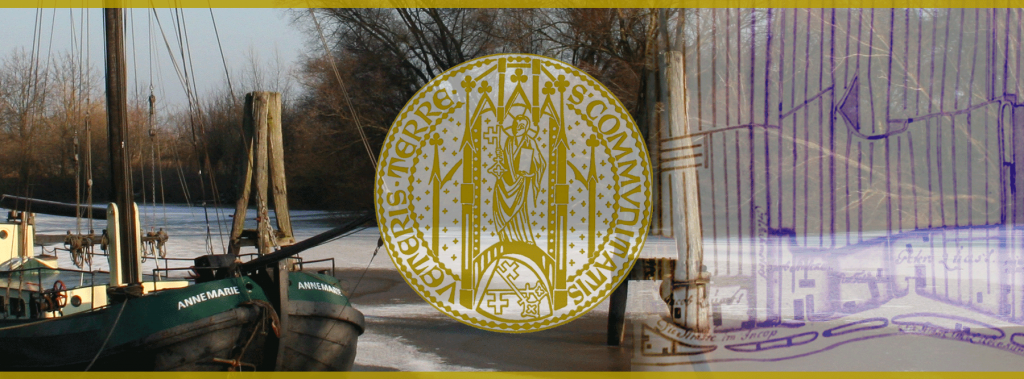SUPPORTING SECTORS:
FRUIT TRADE, SHIPPING, TOURISM
Fruit trade
When exactly professional fruit merchants began working in the Altes Land cannot be verified. It usually stemmed from heirs who had to build a new livelihood. Fruit merchants were found in many cities, but especially in Hamburg and Bremen. Trade relations between the Altes Land and Hamburg were almost unavoidable. They date back to the Middle Ages, but were not always without conflict.
1581 – 1611 Cherry war between Hamburg and the archbishopric of Bremen
Hamburg beer was not allowed to be brought into Bremen, so the Hamburg Council responded by banning the sale of Altländer cherries and fruit.
In 1848, the Altländer fruit merchant Johann Köpke and his family moved to Berlin in a sculler in order to sell Altländer fruits from the boat. In 1930, the Altländer Bezugs- und Absatzgenossenschaft GmbH (“Altländer Purchasing and Sales Cooperative”) in Jork operated its own sales point in the Berliner Großmarkt (“Berlin Wholesale Market”). Today, three producer organisations and three co-operatives market about 70% of the Lower Elbe fruit harvest. Nearly 40 large-scale fruit companies are located in the Lower Elbe region. They attain about 15% of their goods either from the producer organisations or by making direct purchases from unorganised fruit growers. The proportion of self-marketing is about 15%. This is where the producer’s quantity is split into sales to weekly markets and supermarkets. During the 1960s, the first roadside stalls started appearing.
Shipping
Trenches, canals and rivers were used for transportation. Small ports, shipyards and shipping companies developed on the estuaries and tideways, and to this day, they have shipping operations that span around the world. The nautical college in Grünendeich trained countless captains for large and small routes. Today, it’s the home of the Maritime Landschaft Unterelbe (“Lower Elbe Maritime Region”). In earlier times, almost every family had a boat to reach small ports for various purposes, including transporting fruit. Once at a port, dinghies and scullers would aid with the final leg of the transport. These wooden vessels were very shallow sailboats with a flat bottom. The Lühe is the narrowest river in the Altes Land, so in order to cater to the adjacent homesteads, there was a specially made scaled-down version – the so-called “Lühe-Jolle”. As mizzen-scullers (single-masted) and Gik-scullers (double-masted), these extremely seaworthy ships travelled routes to Greenland. Even then, shipbuilders understood how to construct specialised vessels.
By 1920 almost all scullers were motorised and reshaped into small coastal freighters. They remained active in coastal shipping for almost 50 years. Out of these, coasters were developed. Following plans which were conceived by Hamburg designer Adolf Weselmann, the ships were built on the domestic shipyards of Sietas, Rancke and Holst in Cranz-Neuenfelde and the shipyard in Stade. These coasters continued to develop, and were widened and lengthened and thereby brought to 300 GRT. They formed the prototype for the first container ships. An increase in truck-based transportation reduced the number of ship owners, but nevertheless, some families developed into well-known shipping companies who can now look back on an eventful history with a rich tradition. Up until the 20th century, three major shipyards remained in the Altes Land: Rancke, Holst and Sietas, which is still there today.
Tourism
The first travel descriptions to be found date back to 1617. The leisure-based traffic in the 19th century brought about restaurants and ferries. However, as it is known today, tourism is a relatively young economic development.
In the 1970s, tourism received a new boost due to the economic hardship in the fruit growing sector. Committed Altländer decided to expand overnight tourism in order to create a second income. In the 1980s, the expansion of the Altes Land holiday village began; today, it is comprised of about 100 cottages.
For over 20 years, tour guides dressed in traditional costumes have been inviting guests to get a taste of the Altländer culture. Visitor attractions are varied and include: the fruit blossoming season; the cherry and apple harvest; insight into modern commercial pomiculture; the Altländer Apple Days with the “Open Courtyard Day”; the cycling and skater day; festivals such as the Blossom, Apple and Harbour festival; the cherry market; projects such as the “Open Church” or “Regional Food Culture”; the Arp-Schnitger-Geburtstag organ festival, and much more.
